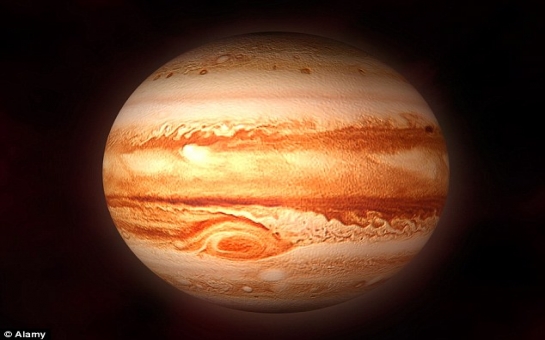From March 1, Jupiter and its four major moons should be clearly visible from anywhere in Britain high in the south as soon as it gets dark using just a pair of binoculars.The planet, which is over 1100 times the size of Earth, will be some 435 million miles from Earth and won't be at such a high point in the sky again until 2026.To celebrate, a series of viewing events has been planned across the country as part of National Astronomy Week, which runs between March 1-8.Steve Miller an astronomer at University College, London (UCL), said: 'Jupiter is the giant of the solar system.'It's over 1100 times larger than our planet Earth and 200 times heavier and it's a very different world from the one we live in. 'It's not made of rock and ocean. It's a huge ball of gas - a gas giant. It has very dynamic weather systems that make it possible to see bands, zones and other features on its surface'.Dr Chris Arridge, also from UCL, said: 'Through binoculars you'll be able to see that Jupiter is distinctly non-star-like and you should be able to make out the Galilean moons of Jupiter - the four largest moons. 'These go around Jupiter in a matter of days and so you'll be able to watch them orbit by looking at the giant planet from one night to the next.For an interactive map to find a viewing event near you click here.Jupiter will be best placed during the evening so it won’t be necessary to stay out until the small hours unless you want to'We expect to see the best photos ever of Jupiter taken from the UK,' says NAW Chairman, Dr Robert Massey, “and it will be a great opportunity for everyone to get a splendid view of the giant planet.'In just over a week, Jupiter, the largest planet in the solar system, will be at its highest point in the sky for many years to come. 'Near their closest to Earth, Jupiter and its moons will appear obvious in the sky offering fantastic opportunities to view the giant planet through a telescope.' (dailymail.co.uk)ANN.Az
Stargazers to get best view of Jupiter in years
Society
16:45 | 24.02.2014

Stargazers to get best view of Jupiter in years
British stargazers will be treated to their best view of Jupiter for many years to come next month as the largest planet in the solar system sweeps into prime position in the night sky.
Follow us !










